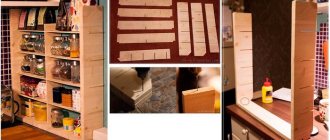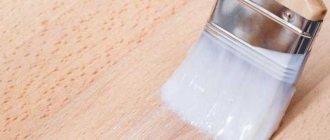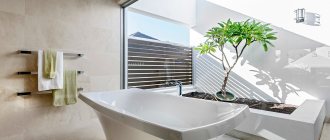What is enamel
Enamel is a glassy formation consisting of oxides of alkali metals, quartz, pigment and other substances treated thermally. Thanks to this, the layer becomes wear-resistant and very durable.
Enamel is not applied to the surface like paint, but appears as a result of high-temperature treatment. Enamel and paint coatings have completely different compositions.
Among household items we use enamel dishes, bathtubs, and jewelry. Enamel can be called a non-transparent glaze applied to ceramics that hides the natural color. The term “enamel” appeared relatively recently. Previously, the word “enamel” was used.
Comparative composition and technical characteristics
Enamel is a paint and varnish material consisting of additives, metals, sand, which is subjected to heat treatment.
The main difference between enamel paints is their increased strength. These compositions consist of pigments and various additives, which are converted into a protective layer; varnish or other substances with similar characteristics are usually used as fillers.
The difference between oil paint and enamel is that the first consists of drying oil, where the same target fillers are added.
Enamel mixtures made from drying oil are classified as paints and varnishes, and there is no specific difference between the materials. It is difficult to determine the difference between enamel and oil paint.
In addition, some manufacturers try to create the illusion of a large selection of their products, and assign different names to paint and varnish materials, taking into account the properties that need to be emphasized. That is, in order to emphasize shine and strength, the manufacturer may call the coating enamel, although this is absolutely not the case.
If we consider how enamel differs from other compositions, then it can be defined as follows: a paint and varnish mixture with the addition of drying oil is called enamel, and using linseed oil is called paint.
Attention: To really determine how oil solutions differ from enamel mixtures, it is necessary to analyze the composition, which differs in the base and the additive used as a mixer.
Consumption per 1 m2
Calculation of consumption depends on the conditions of applying the paint layer. However, the difference can be quite significant. To process the material in one layer, approximately 100-140 g of product per 1 m2 is required.
When calculating the average consumption rate, it is necessary to take into account the quality of the surface being treated, the viscosity of the paintwork material, the location of the painting (apartment, street), and the method of painting (spray gun, brush).
Enameled decorative plate
Enamel paint is a broader concept than just enamel composition. Its components are completely dissolved, so as a result of drying, the surface becomes smooth and glossy.
The characteristics of enamel paints depend on their composition, which plays a decisive role in classification. It would not be wrong to call them a suspension of pigments in binders. They are also called suspensions in varnishes.
When applying enamel paint, the surfaces do not need to be treated, but many people prime them. Painted objects do not fade and are resistant to various types of mechanical damage. Enamel paints mix easily with the desired color, but are toxic and flammable.
Enamel paint provides a durable coating; a thin layer perfectly covers the previous one. From the very first coloring, the tone turns out smooth, beautiful and bright. But due to its lack of resistance to oils, the last layer is varnished.
The composition includes paint and varnish components, pigment, solvents and additives.
Details about acrylic paint
Acrylic paints are mainly used for wall and ceiling structures, and even for some decorative elements. They include the following components:
- polymer acrylic emulsion;
- some of the dyes;
- distilled water.
Let's look at how acrylic paint differs from other media and its advantages:
- The composition dries quite quickly. It hardens within half an hour after application, and reaches full strength in a couple of days;
- High quality, and, consequently, long service life;
- The presence of a film that performs a protective function against moisture, temperature and ultraviolet rays;
- As a difference, it is worth remembering the versatility of the material, which allows it to be used both for painting during the repair process and for decorative painting;
- Environmental safety, allowing active use in the interior space of homes;
- Ease of use, allowing use without additional equipment and professional workers.
Varieties
There are many types of products, but there are three main ones. All others can be classified as subspecies.
Acrylic enamel paint is created on the basis of acrylic resin. Dries quite quickly. Suitable for indoor and outdoor use. It darkens as it dries. Can be coated on concrete, plastered surfaces, glass and wooden objects.
Resistant to moisture, ultraviolet rays, alkaline compounds. Has no smell. The well-known water-based paint belongs to acrylic dyes.
Alkyd enamel paint is made on the basis of alkyd resin. Suitable for painting interior and exterior surfaces of brickwork, wood and metal. Resistant to fairly high temperatures and moisture. However, it is fire hazardous and does not like alkali.
Oil enamel paint is made on the basis of oil varnish. All oil compositions are created on the basis of natural drying oil. Used for decorative and protective purposes. First, the surfaces are primed with drying oil or paint. Used for interior work, painted until a glossy film appears. A matte tone is given by enamels containing wax.
Looking at the photo of enamel paint in our gallery, it becomes clear how it differs from simple enamel
The most popular questions about acrylic paint. Part 2
Today we continue to answer the most popular questions regarding acrylic paints. In the first part of this article we have already discussed many interesting issues.
Is it possible to paint with acrylic paints on fabric?
Any acrylic will adhere to fabric or leather, but we recommend using special fabric paints: they create a flexible coating that will not begin to crack when the material is bent) and contain a heat-setting resin, thanks to which the paint layer will acquire special strength after exposure to temperature (ironing iron or blow dry).
Acrylic paints are distinguished by their bright colors, flexible paint coating and high resistance to aggressive conditions. In this regard, if you correctly apply the design to the fabric, you don’t have to worry about it. Acrylic will not peel off, wrinkle or crumble. This paint easily tolerates temperature changes, mechanical stress and is not susceptible to moisture.
Is it possible to paint with acrylic paint on enamel?
It is advisable to apply a coating of acrylic paint to enamel under certain conditions. Some types of dyes are incompatible, so a neutral intermediate layer is required. To prevent acrylic paint from “curling” the enamel, apply a layer between them that will be resistant to both acrylic and organic solvents. Cover the enamel with liquid putty and then with acrylic primer.
Is it possible to paint batteries with acrylic paint?
Can. Since the temperature of heating radiators is 95-100°, they are often coated with acrylic paints. Acrylic can easily withstand this temperature.
Is it possible to paint metal with acrylic paint?
Coating steel, aluminum, copper and other metal objects with acrylic is not only possible, but also necessary to increase service life and protect the surface. Acrylic can prevent corrosion. In addition, acrylic paint is characterized by strong adhesion to the surface being painted, resistance to temperature changes and resistance to metal deformation.
Is it possible to paint wood with acrylic paint?
Acrylic painting on wood is quite popular. The peculiarity of acrylic paints is that they are easily washed off with water during use and form a durable film after drying. It is resistant to moisture and aggressive influences. The wooden surface under the acrylic coating can “breathe” and is also protected from pests thanks to it.
Is it possible to mix acrylic paints with gouache?
The combination of acrylic and gouache is allowed, since both paints are water-based. At the same time, the properties of the pigments will be preserved. If you don’t have a color scheme on hand, then mixing these paints is a great way to achieve the desired shade.
Is it possible to paint on nails with acrylic paint?
Acrylic paints are widely in demand due to their advantages over other pigments. Acrylic is so versatile that it can be used on almost any surface, including nail plates. Paints applied as a manicure or pedicure provide bright and rich shades.
Good solubility with water during work, ease of mixing to obtain all kinds of tones and quick drying have made acrylic popular in the nail service. In addition, acrylic paints, unlike other water-based pigments, do not dissolve after hardening, which makes it possible to apply additional elements to the drawing.
The acrylic design is sun resistant and allows your nails to breathe.
Is it possible to paint a monument with acrylic paint?
Due to its versatility, acrylic fits well on almost any surface. The surface of the monument painted with acrylic pigment will be resistant to ultraviolet radiation, changes in weather conditions and will retain its original appearance for a long time.
The most popular questions about acrylic paint. Part 1.
Other
Subtleties of application
You should always carefully read what is written on the can. Under no circumstances should paint be used for interior or exterior work, and vice versa.
There is no particular need to putty if the surface is mostly flat and does not have any special defects. It will be enough to clean it well and apply primer. Any thinner or solvent is suitable for enamel paint.
Brands and manufacturers
PF 115 paint, the technical characteristics and price of which attract both private developers and wholesale buyers, is produced by almost all domestic manufacturers of paint and varnish products. Among the most popular brands are Lakra, Yaroslavl paints, Prestige, Rastsvet, Optima and others.
Covering power, consumption, color brightness and other characteristics may vary depending on the manufacturer and their compliance with GOST requirements.
Production
The following companies are called the best manufacturers of enamel paints:
- Tamiya (Japan).
- HUMBROL (It was founded in 1919 in the UK. But it was recently bought by an owner from Ireland).
- Beckers (Sweden).
- Dulux (UK).
- Caparol (Germany).
- Hansa (Germany, Poland).
- Sadolin (Denmark).
These brands have a long history. As a rule, production at the very beginning had nothing to do with dyes. They expanded later when demand arose. All companies have proven themselves, producing products of the highest quality.
Some started out producing single-color paints, like the Japanese company Tamiya. And the very next year there were twelve flowers. Brands could be created in one country and then purchased in another, so production became joint, as happened with the Hansa company.
Domestic manufacturers are working intensively on the quality of their products, and the results please consumers:
- Paint and Varnish Materials Plant “Paints for Painting” (Belgorod region, Rzhevka village. There are many branches. One of them is located in Moscow).
- Factory “SpetsEmal” (products are of high quality. Located in Yaroslavl).
- Company “Pigment” (Russia, St. Petersburg).
Many other factories, companies, and factories produce enamel paints of a wide variety of colors and compositions.
Enamel paint - characteristics
This is a small segment of paints and varnishes, where the compositions are distinguished by high strength characteristics and opacity. In terms of application, these products are popular in industry. Used in cases where it is necessary to stop corrosion processes.
Enamels can be applied in different ways - with rollers, brushes, and a spray gun. The surface must be thoroughly prepared and dry. It is important to clean the surface from remnants of old paint and degrease. For indoor use, enamels such as PF-223, PF-1217, GF-230 are used. As a solvent, you can use white spirit or the solvent specified on the packaging by the manufacturer. But usually it has the same basis.
Photo of enamel paint
Briefly about the main thing
The characteristics of PF 115 enamel are such that it does not lose popularity, despite the presence of higher quality competitors. This is versatility of use for external and internal work, the possibility of application to wooden, metal and mineral substrates, ultraviolet resistance, elasticity, water resistance. Its composition may vary depending on the shade and production in accordance with GOST or TU. Before painting, wooden and concrete surfaces need to be treated with antiseptics, and metal surfaces need to neutralize rust.
Ratings 0











